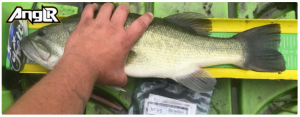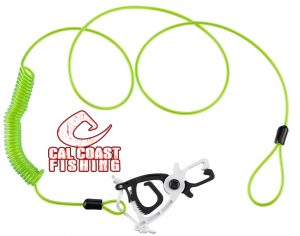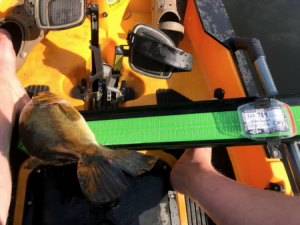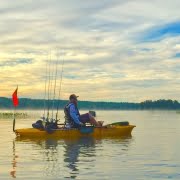 One of the most overlooked challenges when it comes to competing in kayak fishing tournaments, is measuring and photographing your fish. Catching a fish is only half the battle in the Catch, Photograph, and Release (CPR) format.
One of the most overlooked challenges when it comes to competing in kayak fishing tournaments, is measuring and photographing your fish. Catching a fish is only half the battle in the Catch, Photograph, and Release (CPR) format.
Without fail, after every kayak fishing tournament, there will be an angler sharing the tale of a tragic mishap where their prized catch jumped off their measuring board and back into the water. Now, this is sometimes used as a great way to avoid admitting you got skunked but oftentimes, it really is just a series of unfortunate events. Some fish are easier to calm down than others and with every catch comes an unpredictable adventure.
Over the years, I’ve competed in many kayak fishing tournaments, and through those I’ve picked up a lot of tips and tricks for successfully measuring and photographing fish. Everyone has their own slightly unique process for photographing fish but here are some helpful tips that would have really helped me in the early days.
Tethered Fish Grips
Using fish grips or any other tether that allows for a fish to stay in the water while you prepare to measure is crucial. This is a step that not only ensures that your catch isn’t harmed in the process but it also allows the fish to tire itself out further. Doing this, in theory, makes for a more cooperative fish when it’s time to place them on your measuring device. I was informed about this great trick by a friend and fellow kayak angler and I’ve been so grateful for it ever since.
Of course this trick isn’t perfect but in my experience it’s super effective.
 To use fish grips effectively, you’ll need to buy the type of fish grip that will work best for you. Throughout my local club, there are a variety of different fish grips being used. For me personally, I use the Donkey Leash from Cal Coast Fishing. This little grip is deceiving, it’s extremely strong and built in a way that prevents you from accidentally releasing a fish (I’ve only done this once but it was enough). Other anglers use the Fish Grips brand which offer a great quality product at a really approachable price. You can’t go wrong with either choice but make sure you fasten the grips to your kayak using paracord or a Neverlost leash.
To use fish grips effectively, you’ll need to buy the type of fish grip that will work best for you. Throughout my local club, there are a variety of different fish grips being used. For me personally, I use the Donkey Leash from Cal Coast Fishing. This little grip is deceiving, it’s extremely strong and built in a way that prevents you from accidentally releasing a fish (I’ve only done this once but it was enough). Other anglers use the Fish Grips brand which offer a great quality product at a really approachable price. You can’t go wrong with either choice but make sure you fasten the grips to your kayak using paracord or a Neverlost leash.
It may seem obvious but I’ve heard a few instances where anglers have forgotten to tie down their fish grips and a fish has taken off. A final word about these two, they grip the fish’s lip without requiring a puncture hole. This goes a long way to ensure that little to no harm is done to your catch.
Measuring and Photographing
As a kayak angler, I don’t consider myself to be any kind of photographer but when fishing competitively, you’ll need to get really comfortable using your phone with one hand. This is one part of competing in kayak fishing tournaments that’s often overlooked and underestimated. Often times we land a good fish and get pumped because we think we’ve just moved up the leaderboard. In kayak fishing tournaments, catching the fish is half the battle, the second challenge is getting a fish to cooperate long enough for a clear detailed photo that displays that fish’s length.
First things first, be sure that your kayak is organized. If you go on the leaderboard for a kayak fishing tournament you’ll see some people have lures and gear all over the place in their photos. While this can be fine for them, you’ll be surprised at how tough it can be to get all of your gear together after landing a large fish. I find myself shaking and not able to think straight for a few seconds and if my phone and measuring board aren’t in easy to reach places, I could risk knocking some expensive gear out of the boat or potentially even losing the fish. I always keep my measuring board and phone in the same spot. If I need to use them for any reason, they’re easy to grab and always return to the same place. This may sound crazy simple and obvious but trust me, it’ll go a long way.

Some clubs have differing rules when it comes to photographing and measuring fish but for the sake of this article, I’m going to be basing the remainder of this section on the KBF rules.
I won’t get into all of them, but the key rules to focus on, the fish must be facing left, mouth must be closed, the tournament identifier must be visible and able to be read. On top of these rules, you must be using a KBF approved measuring board. There are also some rules regarding where your hand placement can and cannot be in the case that a fish needs some help laying flat on the board.
When it comes to getting a fish to lay flat on the board, always let the fish swim for a bit while tethered to your fish grips as we mentioned above. When the fish has had some time in the water, be sure to dip your measuring board in the water you are fishing. This will ensure that the board isn’t too hot and also helps prevent damage to a fish’s slime coat. Once the board is ready, I like to get my phone out and the camera activated. I use a tether for my phone so once the camera is on, I just keep it on my lap.
Now for the fish, carefully pull your catch up and release your fish grips.
Once you do that, slowly lay the fish down on the board with its head facing left and against the gate of your measuring board. One tip is to use your feet to tilt your board. This puts the fish’s weight against the gate of your measuring board but also aids in keeping a fish’s mouth closed. When the board is tilted in a particular direction, it helps predict what direction a fish will flip should it decide to jump.

I always keep my net on the gate side of my measuring board in the instance a fish jumps, hopefully I’ll catch it.
Once your fish has calmed down and is laying still, grab your phone and snap a picture. Be sure to take a couple of photos just in case one doesn’t come out correctly. It is also a great idea after you take a photo to put your fish back on the fish grips while you make sure your photos look good and meet the submission criteria.
Uploading to Tournament Software

After you snap a clear photograph of your fish, you’ll need to submit that photo to your tournament software so that it can be judged. Be sure that location services are enabled on your camera so that your GPS location can be captured, this proves you were within the tournament limits when your fish was caught. Once the app is open, select the photo that’s clear and submit to the leaderboard.
If you find yourself without service, apps like TourneyX have a Livewell feature which allows you to get the fish in the app to be submitted at a later time. Just remember when you put fish in there that you have to plan to leave the water a bit early in order to find a signal to fully submit those catches.
Measuring and submitting fish can be intimidating at first, but with the right steps it becomes second nature. Like everything, practice makes perfect!
This article was contributed by an ANGLR Expert
Become an ANGLR Expert and apply here.




